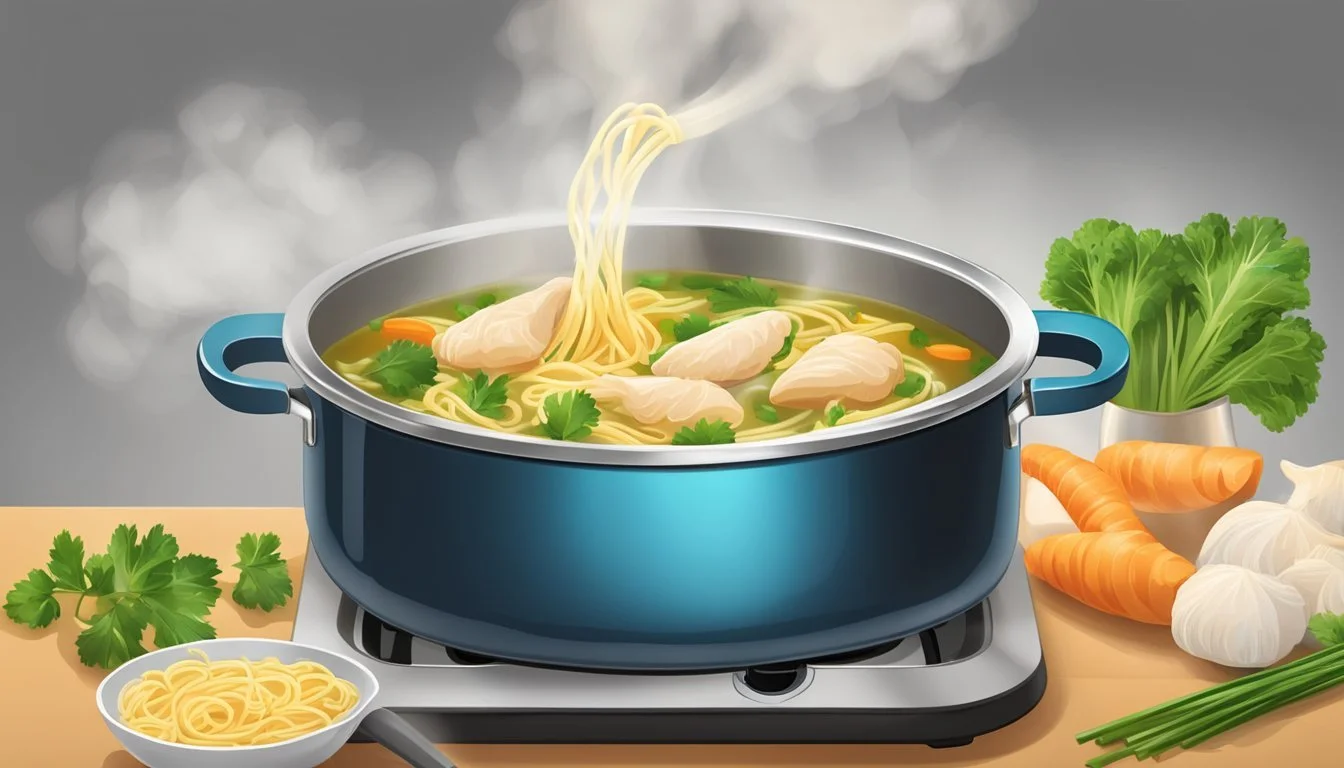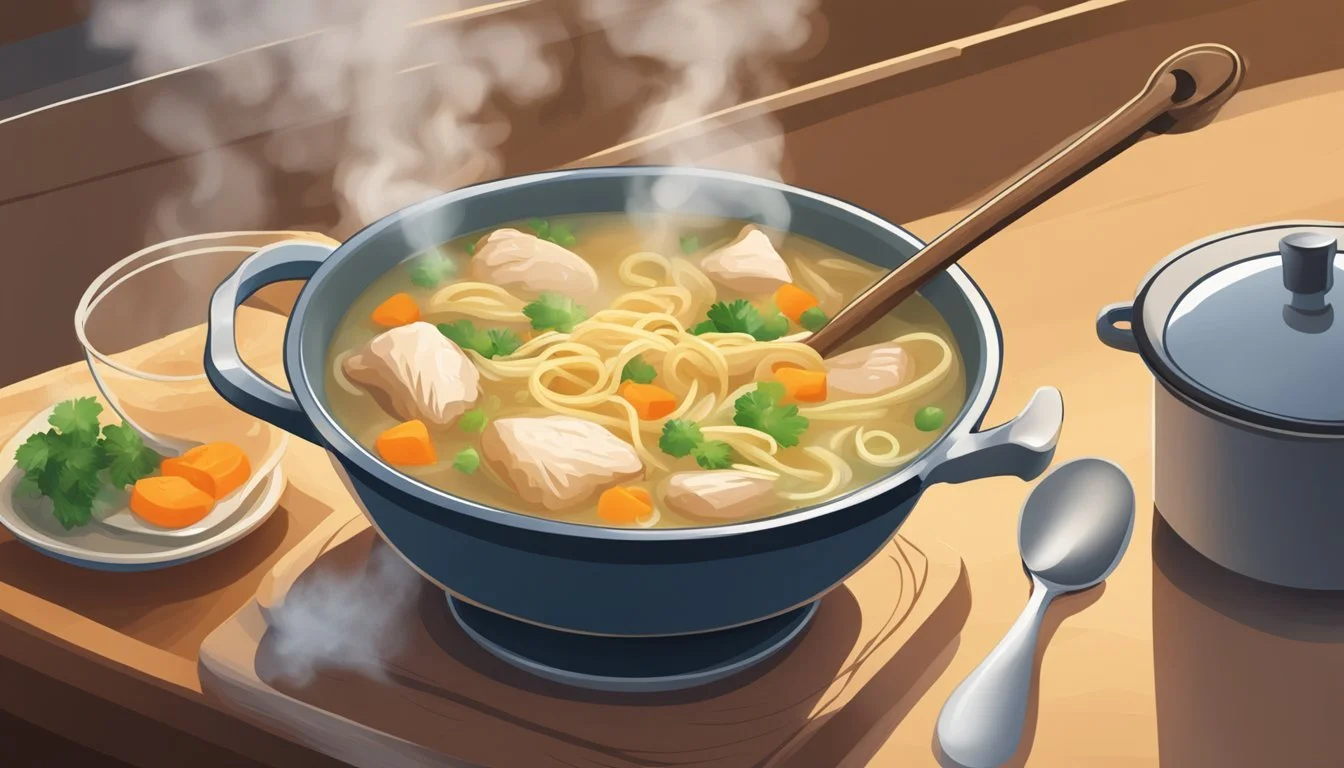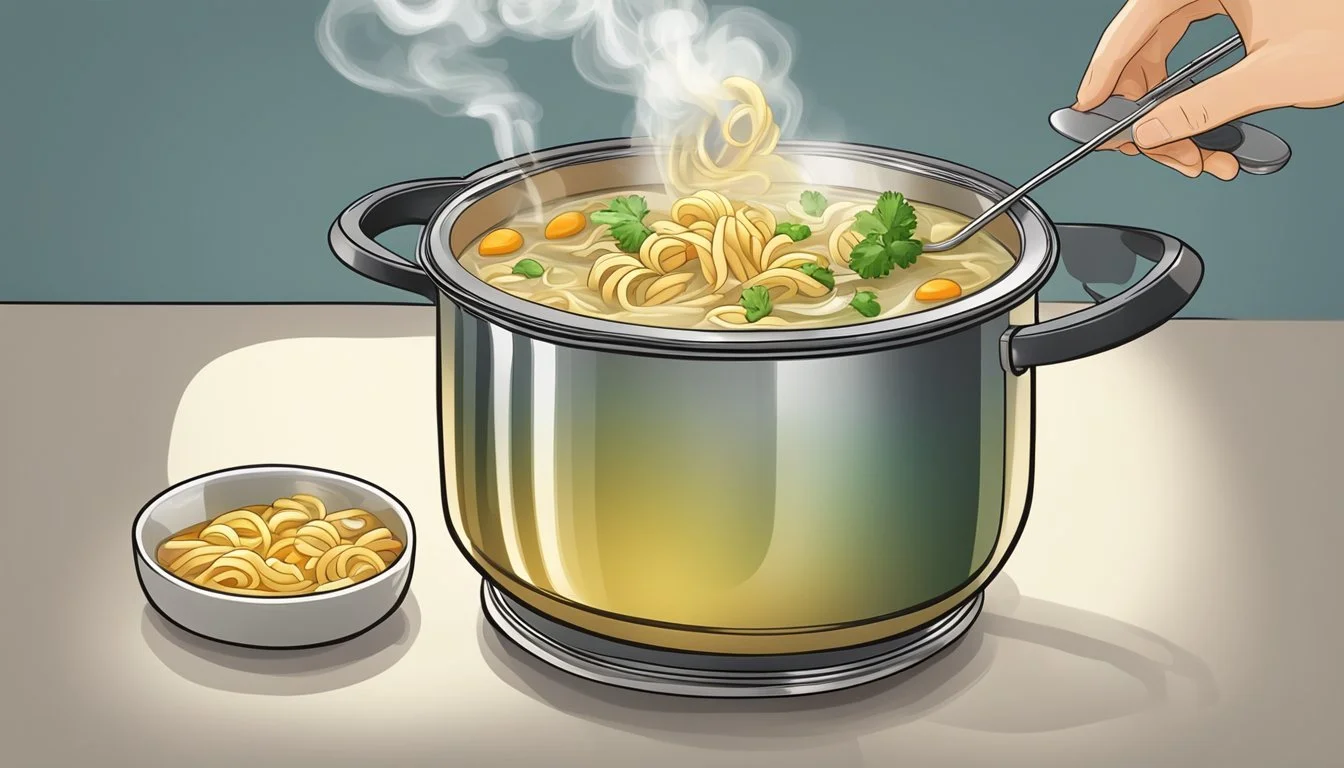How to Reheat Chicken Noodle Soup
Effortless Steps for Perfect Warmth
Chicken noodle soup is a comforting and timeless meal, perfect for cold days or when one needs a bit of warmth. Reheating chicken noodle soup properly ensures that it remains as flavorful and enjoyable as when it was first made. The process can be easily handled using common kitchen appliances while maintaining the texture of the noodles and the richness of the broth.
For those short on time, the microwave offers an efficient solution. By placing a single portion in a microwave-safe bowl, covering it, and heating in short increments, one can enjoy hot, delicious soup in minutes. Alternatively, the stovetop method involves gently warming the soup in a pot over medium heat, which evenly reheats the soup without compromising its quality.
For those preferring an oven, pouring the soup into an oven-safe dish, covering it with foil, and baking until heated through offers another effective method. Each of these techniques caters to different needs and ensures the soup retains its comforting and hearty essence.
Understanding Chicken Noodle Soup
Chicken noodle soup is a comforting dish, typically enjoyed for its savory flavor and beneficial properties. To appreciate its nuances, it's essential to examine the core components and understand the advantages of reheating it properly.
Components of Chicken Noodle Soup
The key ingredients of chicken noodle soup include a clear broth, chicken pieces, noodles, and vegetables. Broth forms the soup's base and can be homemade or store-bought. It provides a savory foundation that enhances the soup’s flavor.
Chicken pieces add protein and texture. Using dark or white meat influences both flavor and tenderness.
Noodles, often egg noodles, give the soup body and make it more filling. They absorb the soup's flavor during reheating, improving the overall taste.
Vegetables like carrots, celery, and onions contribute nutrients and different textures. Each component plays a vital role in creating a balanced, rich flavor and a comforting culinary experience.
Benefits of Proper Reheating
Reheating chicken noodle soup correctly ensures food safety and preserves its quality. Proper reheating restores the soup to a temperature that kills any potential bacteria, making it safe to consume. Microwave reheating should be done in short intervals, stirring in between, to evenly distribute heat.
Stovetop reheating is advantageous for large quantities, allowing even heating and better control. Maintaining the integrity of the ingredients is crucial; overcooking can turn noodles mushy and make the chicken tough.
Reheating can also enhance flavors by allowing the ingredients more time to meld together, making each bowl taste as good as fresh. Proper technique ensures the soup remains satisfying and nutritious, whether enjoyed immediately or after being stored.
Before Reheating
Properly storing and thawing chicken noodle soup ensures it retains its flavors and remains safe to eat. Follow these guidelines for effective storage and correct defrosting methods.
Storage Tips
When storing chicken noodle soup, it is essential to use the right container. Airtight containers are recommended to preserve freshness and prevent contamination. Transfer the soup into a clean, airtight container, and ensure it is sealed tightly.
Refrigeration is suitable for short-term storage. Store the soup in the refrigerator if you plan to consume it within 3-4 days. For longer storage, freezing is ideal. Leave about an inch of space at the top of the container to allow for expansion during freezing. Label the container with the contents and the date it was stored to keep track of its freshness.
Thawing Guidelines
Thawing is a crucial step before reheating frozen chicken noodle soup. Move the container from the freezer to the refrigerator to thaw overnight. This method preserves the texture and flavor of the ingredients while keeping the soup within safe temperatures.
For a quicker thawing process, place the sealed container in a bowl of cold water. This method accelerates defrosting without compromising food safety. Avoid using hot water, as it can create uneven temperatures and promote bacterial growth.
Never thaw soup at room temperature, as this can lead to unsafe bacterial growth. Proper defrosting ensures the soup is evenly thawed and ready for reheating.
Reheating on the Stovetop
Reheating chicken noodle soup on the stovetop is a reliable method that allows for precise control over temperature and texture. This method ensures the soup is evenly heated without compromising flavors or overcooking the ingredients.
Preparation
Start by selecting a suitable pot large enough to hold the portion of chicken noodle soup you intend to reheat. Ensure the pot has a well-fitting lid to trap steam and heat efficiently.
Before placing the soup in the pot, check that it is free from any freezer burn or spoilage if it was previously frozen. Fill the pot with the soup and add a small amount of water or stock if necessary to adjust the consistency. This will help in maintaining the texture of the noodles and the overall broth.
Process
Place the pot on the stove and set the heat to medium. It's important to start with medium heat to prevent the soup’s ingredients, especially the noodles, from becoming mushy.
Stir the soup occasionally to ensure even heating and to avoid sticking at the bottom. Continue stirring until the soup begins to steam and small bubbles appear, indicating that it is close to the desired serving temperature.
If the soup starts boiling vigorously, lower the heat slightly to maintain a gentle simmer, which preserves the texture of meat and vegetables.
Ensuring Even Temperature
To guarantee that the soup is thoroughly heated, use a food thermometer to check the internal temperature. The soup should reach at least 165°F (74°C) to ensure it is safe to eat.
Continue stirring occasionally throughout the reheating process. This not only distributes heat evenly but also prevents hotspots that can occur at the bottom of the pot.
If the soup becomes dry, add small amounts of water or stock as needed to maintain its consistency and flavor. Once the right temperature is achieved and the soup is steaming evenly, it is ready to serve.
Reheating in the Microwave
To reheat chicken noodle soup quickly and efficiently, the microwave is a convenient option. By following specific techniques and steps, one can ensure even heating and avoid any common pitfalls.
Microwave-Safe Techniques
Using microwave-safe dishes is crucial. Microwave-safe bowls help evenly distribute heat and prevent splattering. Cover the bowl with a microwave-safe lid or plastic wrap, leaving a small vent to allow steam to escape. This helps the soup heat evenly and keeps the microwave clean.
Selecting the right bowl size is important. Avoid overfilling. Use a bowl that fits well in the microwave with enough room to stir the soup without spilling.
Step-by-Step Microwave Reheating
Portion: Place a single portion of the soup in a microwave-safe bowl.
Cover: Use a microwave-safe lid or plastic wrap with a small vent.
Initial Heating: Microwave on high power for 1 minute.
Stir: After the initial minute, stir the soup to distribute heat.
Continue Heating: Heat in 30-second increments, stirring after each.
Check Temperature: Ensure the soup reaches 165°F (74°C) for food safety.
Serve: Once hot and steaming, serve immediately.
Avoiding Uneven Heating
Uneven heating can result in parts of the soup being too hot or too cold. Follow these tips to ensure even heating:
Stir Frequently: Stirring at regular intervals helps distribute heat.
Short Intervals: Use shorter heating intervals (30 seconds) and stir between each.
Check Temperature: Use a food thermometer to ensure the correct internal temperature, particularly for the chicken chunks.
By implementing these methods, reheating chicken noodle soup in the microwave can be done efficiently and safely.
Reheating in the Oven
Oven reheating preserves the texture and flavor of the chicken noodle soup while ensuring it heats evenly. This method is slower than using a microwave, but it is particularly effective for maintaining the soup's quality.
Oven-Ready Practices
Before starting, ensure the oven is preheated to 350°F (175°C). Use an oven-safe dish and cover it with aluminum foil to retain moisture and prevent the soup from drying out. This helps in maintaining the soup's consistency and avoiding bacterial growth.
If the soup is thick, add a bit of water or broth to keep it from becoming too dense. This ensures proper heating without affecting the taste or texture. Make sure the container is placed on the middle rack for even heat distribution.
Oven Reheating Steps
1. Preheat the Oven: Set the oven to 350°F (175°C).
2. Prepare the Soup: Transfer the soup to an oven-safe dish. Cover the dish with aluminum foil to retain moisture.
3. Reheat: Place the dish in the oven on the middle rack. Heat for 20-30 minutes, or until the soup is hot and steaming. Stir halfway through to ensure even heating.
4. Serve: Carefully remove the dish from the oven. Stir the soup before serving to evenly distribute the heat. If needed, add a bit more broth and stir. Ensure the soup has reached a safe temperature to avoid bacterial growth.
Staying attentive to these steps ensures your chicken noodle soup is reheated safely and deliciously.
Additional Reheating Methods
When reheating chicken noodle soup, various methods can enhance flavors and ensure even heating.
Crockpot Warming
Using a crockpot to reheat chicken noodle soup can be both convenient and efficient. Place the soup into the crockpot and set it on low heat. This keeps the soup from overcooking while distributing heat evenly. Stir occasionally to prevent any ingredients, such as noodles or vegetables, from sticking to the bottom.
This method is especially helpful for large batches, maintaining a consistent temperature for an extended period. It is a great option for gradually warming seafood soup without compromising its delicate flavors.
Alternative Techniques
Other reheating methods include using steaming and double boilers. These techniques prevent the soup from being directly exposed to high heat, reducing the risk of overcooking. Place the soup in a heatproof bowl and set it over boiling water, stirring occasionally to heat it evenly.
A steamer basket can also be used. Though less common, these methods are excellent for reheating without sacrificing texture. In addition to traditional stovetop and microwave methods, these alternative techniques provide more controlled ways to enjoy soups with varied ingredient blends.
Preserving Quality After Reheating
To preserve the quality of reheated chicken noodle soup, it's essential to focus on avoiding overcooking and proper handling of leftovers. These steps help maintain the flavor and texture of the noodles and chicken pieces.
Avoiding Overcooking
Overcooking can ruin the texture of chicken noodle soup, especially the noodles. When reheating, aim for gentle heat to prevent mushy noodles and tough chicken pieces. Use a stovetop, microwave, or an oven method.
Stovetop: Warm slowly over medium heat. Stir frequently to ensure even heating without boiling the soup.
Microwave: Heat in short bursts, covering the bowl to prevent splatters. Stir the soup every minute to evenly distribute heat and prevent overcooking.
Handling Leftovers Again
Proper storage and handling of leftover chicken noodle soup are crucial to maintain its flavor and texture for future servings.
Storage: Place the soup in an airtight container, leaving space for expansion. Label with the date to track freshness.
Reheating: Follow the reheating guidelines, being cautious not to reheat more than once. This helps prevent degradation of the soup. If the soup has been frozen, thaw in the refrigerator before reheating.
By following these steps, the chicken noodle soup will retain its desirable qualities even after reheating.
Best Practices for Freezing Soup
Properly freezing chicken noodle soup ensures it maintains its flavor, texture, and nutritional value. Key steps include preparing the soup adequately and selecting the right containers to preserve its quality.
Preparation for Freezing
Before freezing chicken noodle soup, let it cool to room temperature. This step is crucial as placing hot soup directly in the freezer can raise the internal temperature, potentially compromising other stored items.
Portioning the soup into single serving sizes is advisable since it facilitates easier reheating. Removing excess air is another important task; it helps prevent freezer burn and preserves the soup's quality. Label each container with the contents and date for easy identification and to keep track of the storage duration.
Using Freezer-Safe Containers
Selecting appropriate freezer-safe containers is vital for freezing chicken noodle soup. Glass containers with tight-fitting lids are a good choice for avoiding leaks and spills. Resealable freezer bags are another excellent option, especially for saving space by allowing the bags to lay flat.
Ensure containers are airtight to prevent any air from getting in, which could lead to freezer burn. Leave about an inch of space at the top of each container to allow for expansion as the soup freezes. This practice minimizes the risk of containers cracking or bursting.
Safety Considerations
Reheating chicken noodle soup requires careful attention to prevent food poisoning and ensure proper heating. Follow these guidelines to cook your soup safely.
Preventing Food Poisoning
Bacterial growth occurs rapidly if chicken noodle soup is not stored or reheated correctly. Always keep the soup at safe temperatures, either in a refrigerator below 40°F (4°C) or a freezer below 0°F (-18°C).
Thawing: If frozen, thaw the soup in the refrigerator overnight rather than at room temperature to minimize bacteria growth.
Reheating: Ensure leftovers are reheated to an internal temperature of at least 165°F (74°C). Use a food thermometer to check, as different parts of the soup may heat unevenly. Stir regularly during reheating to distribute heat.
Store leftover soup in shallow containers to cool quickly, reducing the time spent in the "danger zone" between 40°F and 140°F (4°C and 60°C). This reduces the risk of bacteria multiplying to unsafe levels.
Monitoring Reheating Temperatures
Use accurate methods to measure the internal temperature of the soup during reheating. When using a microwave, stir the soup after each heating interval.
Microwave: Place the soup in a microwave-safe bowl and cover it to prevent splatters. Heat in one-minute intervals, stirring between each phase to ensure even heating. Check the temperature in multiple spots of the soup.
Stovetop: If reheating on the stove, use medium heat and stir continuously. This method helps maintain the soup's texture and flavor while ensuring even heat distribution.
Regularly check the internal temperature with a food thermometer to ensure it reaches 165°F (74°C), which is the safe threshold to kill harmful bacteria and prevent food poisoning.
Conclusion
Reheating chicken noodle soup is a straightforward process, ensuring that the flavor and texture remain delicious. Using a microwave, stovetop, or even an oven, each method offers its own benefits for efficiently reheating leftovers.
For the microwave method, place a single portion of soup in a microwave-safe bowl. Cover it to prevent splatters. Heat for about 1 minute, stir, then continue in 30-second intervals until fully warmed.
The stovetop method is ideal for larger quantities. Pour the soup into a saucepan and heat on medium, stirring occasionally to distribute heat evenly. This ensures that the flavor and texture are preserved.
For frozen chicken noodle soup, thaw it in the refrigerator overnight if possible. Then reheat using either the microwave or stovetop method. Be sure to stir frequently to ensure even heating.
Useful Tips:
Adjust Seasoning: Reheated soup might need a pinch of salt or a dash of acidity like lemon juice to brighten the flavors.
Avoid Overheating: Overheating can cause the noodles to become mushy and the broth to evaporate.
Meal Prep: Store soup in freezer-safe containers, leaving space for expansion, to make meal prep and future reheating simpler.
Reheating chicken noodle soup properly ensures that leftovers are just as delightful as when first prepared. Simple steps and attention to detail can make a significant difference.







